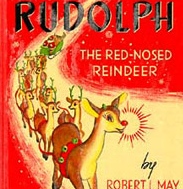The True Story of Rudolph the Red-Nosed Reindeer

Where did the Story of Rudolph Come From?
Courtesy of Inspire21.com
To most of us, the character of Rudolph the Red-Nosed Reindeer -immortalized in song and a popular TV special – has always been anessential part of our Christmas folklore. But Rudolph is a decidedlytwentieth-century invention whose creation can be traced to a specifictime and person.
Rudolph came to life in 1939 when the Chicago-based Montgomery Wardcompany (operators of a chain of department stores) asked one of theircopywriters, 34-year-old Robert L. May, to come up with a Christmasstory they could give away to shoppers as a promotional gimmick. (TheMontgomery Ward stores had been buying and giving away coloring booksfor Christmas every year, and May’s department head saw creating agiveaway booklet of their own as a way to save money.) May, who had apenchant for writing children’s stories and limericks, was tapped tocreate the booklet.
May, drawing in part on the tale of The Ugly Duckling and his ownbackground (he was often taunted as a child for being shy, small, andslight), settled on the idea of an underdog ostracized by the reindeercommunity because of his physical abnormality: a glowing red nose.Looking for an alliterative name, May considered and rejected Rollo (toocheerful and carefree a name for the story of a misfit) and Reginald(too British) before deciding on Rudolph. He then proceeded to writeRudolph’s story in verse, as a series of rhyming couplets, testing itout on his 4-year-old daughter Barbara as he went along. AlthoughBarbara was thrilled with Rudolph’s story, May’s boss was worried that astory featuring a red nose — an image associated with drinking anddrunkards — was unsuitable for a Christmas tale. May responded by takingDenver Gillen, a friend from Montgomery Ward’s art department, to theLincoln Park Zoo to sketch some deer. Gillen’s illustrations of ared-nosed reindeer overcame the hesitancy of May’s bosses and theRudolph story was approved. Montgomery Ward distributed 2.4 millioncopies of the Rudolph booklet in 1939, and although wartime papershortages curtailed printing for the next several years, a total of 6million copies had been given by the end of 1946.
The post-war demand for licensing the Rudolph character wastremendous, but since May had created the story as an employee ofMontgomery Ward, they held the copyright and he received no royalties.Deeply in debt from the medical bills resulting from his wife’s terminalillness (she died about the time May created Rudolph), May persuadedMontgomery Ward’s corporate president, Sewell Avery, to turn thecopyright over to him in January 1947. With the rights to his creationin hand, May’s financial security was assured. “Rudolph the Red-NosedReindeer” was printed commercially in 1947 and shown in theaters as anine-minute cartoon the following year. The Rudolph phenomenon reallytook off, however, when May’s brother-in-law, songwriter Johnny Marks,developed the lyrics and melody for a Rudolph song. Marks’ musicalversion of “Rudolph the Red-Nosed Reindeer” (turned down by many whodidn’t want to meddle with the established Santa legend) was recorded byGene Autry in 1949, sold two million copies that year and went on tobecome one of the best-selling songs of all time (second only to “WhiteChristmas”). A TV special about Rudolph narrated by Burl Ives wasproduced in 1964 and remains a popular perennial holiday favorite in theUSA.
May quit his copywriting job in 1951 and spent seven years managinghis creation before returning to Montgomery Ward, where he worked untilhis retirement in 1971. May died in 1976, comfortable in the life hisreindeer creation had provided for him.
In closing, although the story of Rudolph is primarily known to usthrough the lyrics of Johnny Marks’ song, the story May wrote issubstantially different in a number of ways. Rudolph was not one ofSanta’s reindeer (or the offspring of one of Santa’s reindeer), and hedid not live at the North Pole. Rudolph dwelled in an “ordinary”reindeer village elsewhere, and although he was taunted and laughed atfor having a shiny red nose, he was not regarded by his parents as ashameful embarrassment. Rudolph was brought up in a loving householdand was a responsible reindeer with a good self-image and sense of worth.Moreover, Rudolph did not rise to fame when Santa picked him out fromthe reindeer herd because of his shiny nose. Santa discovered thered-nosed reindeer quite by accident, when he noticed the glow emanatingfrom Rudolph’s room while delivering presents to Rudolph’s house.Worried that the thickening fog — already the cause of several accidentsand delays — would keep him from completing his Christmas Eve rounds,Santa tapped Rudolph to lead his team, observing upon their return: “ByYOU last night’s journey was actually bossed. Without you, I’m certainwe’d all have been lost!”
Merry Christmas to you and yours!
Etc.
Please use the Share Buttons and/or email the post link below directly to your friends. Share the true story of Rudolph.
The True Story of Rudolph the Red-Nosed Reindeer
Thanks.
I appreciate it.

